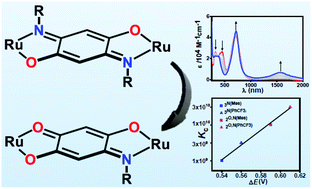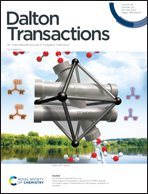Dinuclear RuII complexes with quinonoid bridges: tuning the electrochemical and spectroscopic properties of redox-switchable NIR dyes through judicious bridge design†‡
Abstract
Bridging quinonoid ligands are important platforms for generating metal-based switchable optoelectronic and magnetic materials. A possible sound way of influencing the properties of the aforementioned materials is to modify the direct metal–ligand interface. We present herein a series of dinuclear RuII complexes where the set of donor atoms at the bridging quinonoid ligands range from [O,O,O,O], [O,O,O,N], [O,N,O,N] and [O,N,O,N′]. Additionally, the substituents on the N-donors were varied as well (a total of eight different quinonoid bridges are compared). We also present a mononuclear RuII complex for comparison purposes. The dinuclear complexes act as switchable NIR dyes, absorbing in the NIR region in their mixed-valent RuII/RuIII form but not in the neighboring RuII/RuII and RuIII/RuIII states. The switching potentials (the potentials at which NIR absorptions appear) and the λmax of the NIR band can be fine-tuned by varying the donor atoms as well as the electron-donating ability of the substituents on the nitrogen atoms (tuning E by ca. 0.4 V and λmax by ca. 450 nm). Introducing more electron-rich substituents at the nitrogen atoms of the bridge results in higher band energies and more cathodic redox potentials. Unsymmetrical bridging ligands increase the thermodynamic stability of the mixed-valent state. Whereas almost all of the mixed-valent species presented here belong to the delocalised type III of the Robin–Day classification, the most unsymmetrical complex 2O,N(Mes) shows characteristic signs of a borderline Class-II–III compounds. This comprehensive study thus establishes the lesser used unsymmetrically substituted quinones as excellent bridges for generating and tuning a series of properties in their corresponding metal complexes.



 Please wait while we load your content...
Please wait while we load your content...